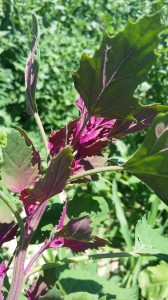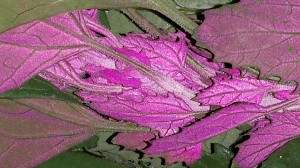Leffler Family Farms’ August 6th Farm Update

Hello Everyone!
Around the Farm…
It’s finally August and that means the sweet corn is right around the corner! Although the first month of this season has not been incredibly productive with the early hail, we are very hopeful for a strong, productive, final three months. Everything is really starting to shape up nicely. The basil plants are growing like crazy as are the tomatoes and peppers. This year is really different from last though with our peppers and tomatoes about 2-3 weeks behind from this same time of year last season. Considering we had devastating hail last year on August 2nd, everything is looking way better than one year ago today. The rain in the last week has been a real blessing, one that should really not be taken for granted and one that we are very grateful for.
Next on the harvest schedule for the upcoming weeks: Japanese eggplant, some of the spicy peppers like serrano, sweet corn, and dry bulb onions.
Fall Planting Continues
We are still sowing seeds and transplanting in the greenhouse in preparation for fall harvest. The kale and collards are finally getting big enough that the flea beetles cannot affect them much, so they are finally growing! We are going to plant more radish, carrots, cukes, green beans, edamame, beets, and turnips for fall. These crops, with the exception of the beets, faired poorly with the bad weather. They were the ones that were at the most vulnerable stage because they were just tiny seedlings emerging from the soil when the hail hit them. Red and green cabbage will be transplanted this week in the greenhouse and we will direct sow our Napa Cabbage this week. Hopefully we can harvest enough to make some great homemade kimchi.
——————————————————
This Week’s Share*
*shares may vary slightly from list due to the sometimes unpredictable nature of harvesting.
Rainbow Beets
Assorted Summer Squash
Green Bunching Onions, Tokyo Evergreen
Rainbow Chard
Baby Dill
Sweet Basil and/or Lemon Basil
Squash Blossoms (for some – always rotating!)
Magenta Spreen Greens
Sweet Corn next week!
——————————————————
How to Chiffonade Basil
——————————————————
Veggie Spotlight: Magenta Spreen

Last year, we planted Magenta Spreen for the first time and used the stunning baby leaves in salad mixes. This season, as the plant’s description promises, the pretty green came back on it’s own. Un-cooked, I think it tastes similar to raw green beans. Cooked, it tastes like spinach or chard, some say with a hint of asparagus (it is, after all, a member of the beet and spinach family, Chenopodium). The plant contains lots of vitamins A, C and K and also calcium, iron, phosphorous and potassium and saponins*. With all that nutritional value, Magenta Spreen would surely be a great addition to a juicing regimen.
If you would like to learn more about Magenta Spreen, check out the links below  .
.
|
|||||||||||||||||||||||||||||||||||||||
|
A leafy green named magenta spreen
Would a rose by any other name smell as sweet? Eat some beautiful spreen and get back to us on that one.
|
|||||||||||||||||||||||||||||||||||||||
|
Preview by Yahoo
|
|||||||||||||||||||||||||||||||||||||||
|
PLANT OF THE WEEK: Magenta spreen / Pretty and pro…
If you like spinach and enjoy cooking with it, consider growing magentaspreen (ma-gent-uh-SPREEN).
|
|||||||
|
Preview by Yahoo
|
|||||||
*Saponin Sources and Uses
Saponins occur naturally in soybeans, peas, ginseng, herbs, vegetables and yucca. They are phytochemicals, or plant chemicals, possessing detergent qualities that foam when mixed with water. Commercially, saponins appear in beverages and cosmetics as emulsifiers or sweeteners. They’re also fed to livestock to cut down on odor because they bind to ammonia, which contributes to foul smells.
Cholesterol Lowering
If you’re working to lower your cholesterol level, eating foods rich in saponins may help. Your body uses cholesterol to make bile acids needed for proper digestion. When you eat, bile acids are released into your intestines. The detergent qualities of saponins allow them to bind to bile and prevent its reabsorption. Once bound to saponins, cholesterol leaves your body in waste. Peter R. Cheeke, Ph.D., from the Linus Pauling Institute, notes that many cholesterol-lowering medications perform the same role, and over time excretion of bile may help lower your cholesterol.
Improved Immune Function
Eating more saponins may boost your immune function and fight off fungal infections, according to an article published in “ACS Chemical Biology” in March 2010. The study noted that saponins cause death of fungal cells, such as Candida albicans, which is responsible for yeast infections, thrush and many hospital-acquired infections. Saponins appear to enhance your immune system’s ability to fight off viruses and parasites as well. Pharmaceutical manufacturers often include saponins in vaccines to increase their effectiveness.
Preventing Cancer
According to an article published in the “Journal of Nutrition” in 1995, saponins found in soybeans slow the growth of human cancer cells. These plant compounds may also cause the death of tumor cells, according to an article published in the journal “Phytochemistry Reviews” in June 2010. (http://healthyeating.sfgate.com/health-benefits-saponins-9131.html)
——————————————————
You don’t have to cook fancy or complicated masterpieces – just good food from fresh ingredients.
JULIA CHILD
——————————————————
Questions and comments always welcome!
Have a great week!
Anthony ad Sarah
Leffler Family Farms
Local Motion CSA
970-689-2355
(f) 970-454-3588



